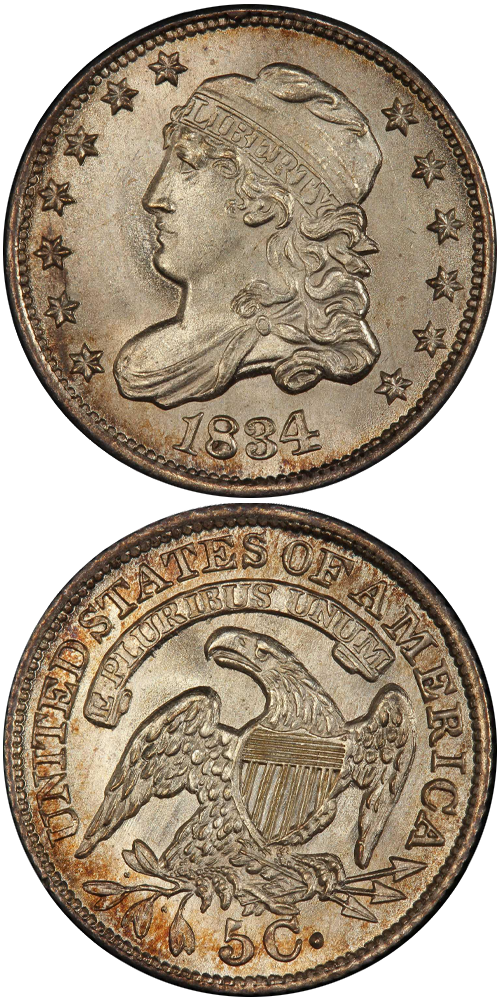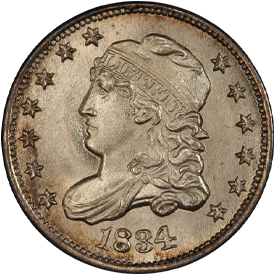Designed by: William Kneass adapting the design of John Reich
Issue Dates: 1829-1837
Composition: 89.24% silver, 10.76% copper
Diameter: 15.5 mm
Weight: 1.34 grams (20.8 grains)
Edge: Reeded
Business Strike Mintage: 13,058,700
Following a span of years from 1806 to 1828, when no half dimes were minted, the Capped Bust style was introduced in 1829. The design is quite similar to that used on the half dollar 1807-1836, by John Reich, and was modified from that source by William Kneass, Mint engraver. The obverse features Miss Liberty facing to the left, her hair covered by a cloth cap secured by a band inscribed LIBERTY, with tresses flowing down to her shoulder. Her neckline is draped with a gown, secured with a brooch at the shoulder. Seven stars are to the left and six to the right. The date is below. The reverse features an eagle with the shield on its breast, perched on a branch and holding arrows, with E PLURIBUS UNUM on a scroll above, and UNITED STATES OF AMERICA and 5 C. surrounding.
The span of coinage from 1829 through 1837 contains no rare dates (although some individual die varieties within the dates are elusive), so the type set collector has his choice of the entire range. Specimens seen today are most often encountered in grades from Very Good through Very Fine, and these are fairly plentiful. Extremely Fine and AU pieces can also be found with frequency. Uncirculated coins are scarcer yet, with truly Gem Uncirculated pieces being elusive. Most issues within the range are well struck, so it is possible to pick the grade you want and acquire a piece with excellent design detail definition.
Further Reading
In 1829 a new half dime design made its appearance, the Capped Bust type, a style following that used on half dollars from 1807 through 1836. No half dimes were minted from the years 1806 through 1828 inclusive. Had they been, the Capped Bust design would have been introduced earlier, as it was with other denominations.
This style of half dime was minted with little variation from 1829 through 1837. Some differences occur in lettering sizes, but most numismatists seek examples only by dates or, in the instance of type collectors, a single specimen of the design. One interesting variety of 1834 has the 3 in the date punched backwards and then corrected! This is a rather spectacular blunder when viewed with a low-powered magnifying glass. While "tradition" has been responsible for the listing in coin references and the popularization of the 1796 LIKERTY and the 1800 LIBEKTY non-varieties, the 1834 with backwards 3 in the date has been overlooked by virtually everyone! Unlike love and war, apparently all is not fair in numismatics!
Half dimes of this type are readily available in a wide variety of grades from very worn through Uncirculated. Around 1970 my firm purchased a small hoard of 50 Choice Uncirculated 1835 half dimes from William K. Raymond. Offered at a price that seems an unbelievable bargain a decade later, the pieces found ready buyers. In proportion to the demand for them, Choice Uncirculated specimens of the various dates of the 1829-1837 design seem to be elusive. Issues of the year 1837 are particularly hard to find in this state of preservation.
Many years ago, I was intrigued, and thought it ironic, when a local woman telephoned to say that she had an 1835 half dime. She brought it to the office, and it indeed proved to be half of a dime – an 1835 dime had been cut in two pieces with tinsnips years ago! The owner did not realize that on its own the term half dime had another meaning.
I carried this piece around in my wallet for a number of years and then misplaced it. It was always a fun item to show to another dealer! Then I read an account of the monetary situation in the Louisiana-Texas area during the 1830s and 1840s and was surprised to learn that from time-to-time United States coins such as dimes and quarters were snipped into fractional pieces to make small change. So, the 1835 "half dime" might have had special numismatic importance after all.







